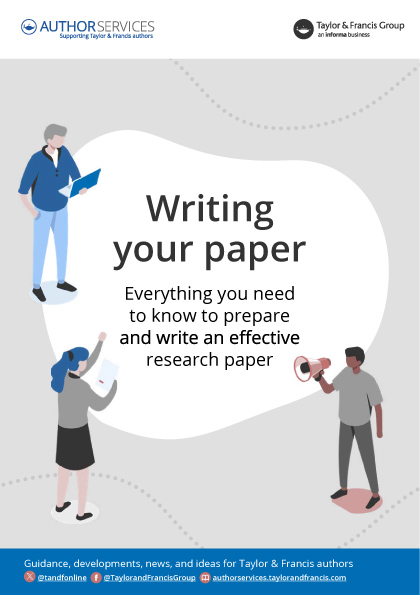Writing your paper
Advice and guidance on preparing and writing an effective research paper
Publishing the results of your research is a critical part of your academic career. By following the advice and guidance here, you’ll be able to produce a paper that’s a great fit for your chosen journal.
Jump to section

Before you start writing up your research, it’s important to have a good idea of which journal you want your paper to be published in.
When writing your paper you should keep the journal you are targeting in mind, to make sure the style, structure and audience are all a good fit.
This helps the editor to see how your work matches with the aims and scope of the journal, and make it more likely to be accepted for publication. Make sure you’ve read the aims and scope for your target journal before you start writing, it will tell you what types of article are accepted.
You’ll find lots more advice on finding the right journal for your research in our section on choosing a journal.

You need to understand what the editor of your target journal will be looking for. By understanding the expectations of both the journal and the publisher, you can write your paper to meet those standards from the start.
Familiarizing yourself with your chosen journal’s instructions for authors (IFAs) is a key part of writing your paper and preparing to submit.
The IFAs tell you exactly what the journal’s editorial board expects to see, including details of specific processes to follow to make sure there are no problems should your article be accepted
It’s important to familiarize yourself with the journal’s own policies, but in addition, you should also review the Taylor & Francis Editorial Policies that apply across our whole portfolio of journals.
Editorial Policies clearly lay out the standards of reporting expected by the journal/publisher, as well as covering everything from ethics standards to use of third-party material.

The best way to determine how to structure your article is to study your target journal. The right manuscript structure can boost your chances of publishing success.
To save time and for peace of mind, you may want to consider using manuscript formatting experts while you focus on your research.
Look through the journal’s instructions for authors, but also take the time to read a selection of articles already published there to see how they are structured. This will help you to understand what the editor may be looking for.
You could also make use of an article template. Check the instructions for authors for your chosen journal to see if they accept templated articles, then download the article template and instructions.
Sometimes there are specific templates available to use, for example the Article Template and Software Tool Article Template for LaTeX users submitting to F1000Research via Overleaf.
Every article is unique, and the structure and the sections you need to include depends on the type of article you’re writing and the subject of study.
Here’s a helpful step by step guide to take you through the standard sections that many researchers need to include when writing a manuscript, in the order in which you would normally write them.
Prepare tables and figures (if required)
When creating tables and figures for your article, check the journal’s instructions for authors, which may specify artwork formatting guidelines such as layouts and use of color.Write up the literature review (if required)
Literature reviews aren’t always needed, but often form an important part of Humanities and Social Sciences manuscripts. Typically, a literature review should discuss what’s already known about the topic of the article, identify gaps in current knowledge and present your approach to addressing those gaps.Write the method
The method section gives the reader all the details of how you conducted your research. Check the instructions for authors for your target journal to see whether there are any specific requirements on how it should be presented. It’s also a good idea to review previously published papers in the journal or sample reports on the journal website.Write up your results
In the results section, you’re answering the question ‘what have you found?’. You should state your findings, but don’t interpret the results or discuss their implications in this section.Write the discussion and conclusions
Your discussion and conclusion are where you interpret your results. Discuss your conclusions in order of most to least important, and end by stating your main conclusions again.Write the introduction
Your introduction should provide the background information needed to understand your study, and the reasons why you conducted your experiments. At the end of your introduction you should include a clear statement of your aims and a brief sentence or two on how you conducted your study. Although your introduction comes first in your article, you’ll have a clearer idea of how to write it once you’ve written the rest of your paper.Write the abstract and create a compelling title
Your abstract is the shop window of your article – this is where customers (researchers) can sample your wares and decide whether to read and cite your content or look elsewhere. Follow our advice on writing the title and abstract for your article using keywords to set up your work to be easily discovered online.

Don’t worry if you’re not a native English speaker. Here’s how to break language barriers and publish in international journals.
What else should I include when writing my paper?
If you are using third-party material in your article, It is important to make sure that you are clear on the guidance you need to follow, as most journals need you to have written permission.
If you need to refer to a data set in your article, you’ll need to make sure that you cite the data appropriately. Read more in our how-to guide on citing data.
There are also specific guidelines to follow when including mathematical scripts and special characters.
Please make sure you read through the Taylor & Francis Editorial Policies which include important information about why and how you should cite sources in your article. These requirements apply to all journals published by Taylor & Francis Group.
Have you considered writing a Plain Language Summary? They can greatly help to communicate the significance of scientific research evidence to a broad audience.
Do you want your scientific paper to be shared with a non-scientific audience, such as policy makers? If so, the recently launched Key Policy Highlights scheme can support you with this.
For more tips and useful advice, we’ve put together a handy guide and video on what to consider when writing your journal article. You can also check out our guide to know what makes a good research paper.
Writing a review article?
A review article, also called a literature review, should give an overview of current thinking on the theme rather than presenting new results. Read our specific advice on writing a review article for more guidance.
Writing a manuscript in a more unusual format?
There may be specific resources available to help you structure and write the article – for example, F1000Research offer detailed instructions for authors for some of their article types, like Data Notes and Registered Report Stage 1 Study Protocols. It’s always worth exploring the journal or platform homepage to see if there are dedicated guides and resources to help you prepare your manuscript.
Everything in one guide
Our manuscript layout guide will help you to format your manuscript to get it ready to submit to a Taylor & Francis journal.
Many journals also allow the use of templates to help you format your article. You can find out if this applies to your chosen journal by checking the instructions for authors.
Then you should visit our formatting and templates page to find the downloadable template files and their instructions.
Publishing tips, direct to your inbox
Expert tips and guidance on getting published and maximizing the impact of your research. Register now for weekly insights direct to your inbox.
Once you have the first complete draft of your paper, make sure it is in the best possible shape before submitting, by editing your manuscript properly. You need to know how to improve your research paper by taking a critical look at your manuscript.
This guide to preparing your article for submission will also show you how to write and refine your paper in confidence. When you’re confident in the final draft of your manuscript, it’s important to check it back against the Taylor & Francis Editorial Policies, and the individual processes and policies of your target journal found in the IFAs.
Guidance may vary by journal, so we’ve listed below a few key areas that you need to pay attention to:
Defining authorship: co-authors, corresponding authors, and affiliations.
The ethical issues you should be aware of as an author.
Declaring competing interests. Also known as a ‘conflict of interest’, full disclosure of any competing interests is required when you submit your paper to a journal.
If your research includes a medical/clinical study you will need written patient consent from your participants. All authors are required to follow the ICMJE requirements on privacy and informed consent from patients and study participants.

If you need more help to get your paper ready to submit, find out how Taylor & Francis Editing Services can help you improve your manuscript. These tailored services make the process of preparing and submitting a manuscript even easier to offer you a smooth journey to publication.

Once you have written your paper and are ready to submit, read our guidance on making your submission to help you through the process.
Have you considered any optional enhancements for your paper?
Plain Language Summaries communicate the significance of scientific research evidence to a broad audience in jargon-free and clear language. Improve public engagement with a Plain Language Summary.
A graphical abstract is a useful tool that provides a concise, visual summary of the main conclusions of your article. It can be a great additional way to communicate your findings.
A video abstract lets you introduce readers to your article in your own words, telling others why they should read your research. They are an increasingly popular way of getting others to engage with published research.



